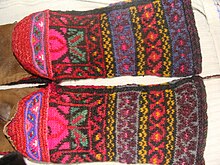| This article includes a list of references, related reading, or external links, but its sources remain unclear because it lacks inline citations. Please help improve this article by introducing more precise citations. (January 2017) (Learn how and when to remove this message) |


Jorabs are multicolored socks with intricate patterns, knitted from the toe-up. They are usually worn in such a way as to display rich decoration.
Etymology
The word "Jorabs" originates from Arabic جورب (jourab) which has a general meaning of "socks". Other known variants of the term are “çorap" (Turkish), "чорап" (Bulgarian, Macedonian) "čarape" (Serbian), “corab" (Azerbaijani), "čarapa" (Bosnian), “Ҷӯроб" (Tajik), and "şətəl" (Tat).
The same concept is also known by such local terms as “kyulyutar” in Lezgin, “tturs” in Tsakhur, and “unq’al” in Avar languages of Dagestan.
Materials
Jorabs are made of wool, silk, nylon or sometimes cotton. Other materials include acrylic and blends of wool and cotton.

Geography
Jorabs are found in Central Asia (Turkmenistan, Tajikistan, and Afghanistan), Caucasus (Dagestan, Georgia, Azerbaijan, and Armenia); also in Iran, and mountain areas of Pakistan. They are also known in the Balkan countries: Albania, Bosnia, Bulgaria, Greece, Macedonia, Serbia, and Turkey.
Shape
Jorabs can be knee-high, regular length, ankle-length, or made as slippers. An early predecessor of jorabs, a knee-high 12th century sock with toe-up construction and intricate patterns, was found in Egypt with possible origin in India.
Tools
Jorabs are usually knitted with 5 double-pointed needles. Bosnian and in old Tajik socks feature a combination of knitting and crochet techniques. Tajik jorabs (Pamirs area) can be made by using crochet technique only. Some ethnic groups from the Caucasus knit jorabs with 3 double-pointed bow-shaped needles.
References
- Macedonianspark.com; macedoniadirect (13 July 2009). "Traditional Macedonian Costumes". Scribd.
- "Knitted Socks". Crafts-bg. 2001. Archived from the original on 24 May 2011.
- Vilensky, Larisa. "From Carpets to Jourabs". Crochet Insider. Archived from the original on 2021-09-26. Retrieved 2019-07-15.
- "Antique Persian Silk Socks from Kurdistan". Textile As Art: Antique Textiles, Woven Treasures. Archived from the original on 2023-01-28. Retrieved 2011-02-18.
- "Jorab". Azerbaijan Carpets. Ministry of Culture and Tourism of the Republic of Azerbaijan. 2010. Archived from the original on 21 March 2012.
- "Balkan Socks". The Archives of Miriam Milgram. Kalinka Press. 2008. Archived from the original on 2019-09-13. Retrieved 2011-06-16.
Books
- Özbel, Kenan (1981). Knitted stockings from Turkish villages. Translated by Uysal, Ahmet E.; Fletcher, Mary; Tahtakılıç, Lesley; Quigley, Maggie E. (1st ed.). Ankara: Türkiye İş Bankası Cultural Publications. OCLC 10914107. (LibraryThing page.)
- Gibson-Roberts, Priscilla (1995). Ethnic Socks & Stockings: A Compendium of Eastern Design & Technique. Photographs by Alexis Xenakis (1st ed.). Xrx Books. ISBN 978-0-9646391-0-2.
- Zilboorg, Anna (2001). Simply Socks: 45 Traditional Turkish Patterns to Knit. Lark Books. ISBN 978-1-887374-59-0.
- Harrell, Betsy (1981). Anatolian Knitting Designs: Sivas Stocking Patterns Collected in an Istanbul Shantytown. Istanbul: Redhouse Press. ASIN B0006EAWVM. OCLC 8931599.